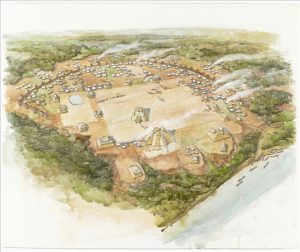When one looks at an archaeological site one of the questions they are trying to answer is what type of society produced this site. There are a lot of different clues within the archaeological site that can tell help answer that question. One good example of how social archaeology works is Moundville.
Moundville was an Ancient Native American site located in Mississippi. It was occupied from AD 1000-AD 1450. It was a village built using Wall-Trench architecture. It was well planned, in a roughly square formation using a mound-plaza layout. It was also a cultural center. We know this because there were remnants of pottery found at the site.
With just the information above we can tell that Moundville was created by a society that was at least a Segmentary Society. In other words, we can tell that the people who built Moundville were not nomadic people. They lived permanently at Moundville. We can tell this because the settlement was protected forests on three sides. The fact that Moundville was built it in a protected area suggests that there was warfare and warfare only occurs once a settlement becomes permanent. This leads us to deduce that they were a Segmentary Society because there was evidence of agricultural as well as hunting found at the sites surrounding Moundville.
We can also infer that Moundville was the social center because there were many smaller sites surrounding Moundville, suggesting that the most people lived in Moundville. The people at Moundville were producing highly sophisticated pottery, which also leads us to believe that it was the center of this society. This also suggests that there a hierarchy.
If a society has enough people where not everybody has to produce food, then there are people who can devote their time to other jobs. Once that occurs, the society also needs a ruler, which creates a hierarchy. We also know that there was some sort of hierarchy because the mounds were different in size. One can infer that the bigger mounds were made for the elite and the smaller mounds for the peasants. This becomes especially apparent when one takes the artifacts that were buried in the mound into account.
In conclusion, with the information given by the archaeology, we have managed to reconstruct the story of the society that lived at Moundville.
Sources:
N/a. “Ancient Site.” Ancient Site. Moundville Archaeological Park, n.d. Web. 13 Feb. 2017.
http://moundville.ua.edu/ancient-site/
Images:
https://www.ua.edu/news/wpcontent/uploads/2005/12/rattlesnake_disk.jpg
http://s821.photobucket.com/user/Ojibwa/media/Moundville.jpg.html
Further Readings:
http://www.encyclopediaofalabama.org/article/h-1045
http://www.ancient.eu/moundville/



What evidence is there to show that there is warfare occurring at this site? There are a ton of mound sites, and archaeological evidence to suggest a large trading network. between all of these sites. Suggesting that warfare didn’t occur at all would be false but could this site location have another importance besides protection? Possible a ritualistic/cultural importance?
There does seem to be a certain religious importance to Moundville. This can be seen in the fact that are multiple different burial mounds throughout Moundville. In each of the burial mounds there specific items placed in the mound which leads one to conclude that these burial mounds have religious significance and that they were not used to bury a population defeated in war. The mounds were usually devoted to only one individual, which also suggests that these burial mounds were used in relgious cerimonies, not mass graves. This is futher supported by the discovery of mounds that were used to spereate the individual burial mounds. The speration of the burial mounds suggets a type of graveyard. Throughout Moundville there are also Temple mounds, which further supports the conclusion the Moundville was had some importance as a religious center.